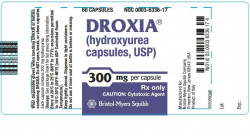Droxia (hydroxyurea) Coupons, Discounts & Cost
Droxia (hydroxyurea) is an antitumor agent. One way to save money on the Droxia (hydroxyurea) retail cost regardless of income and insurance status is to use Droxia (hydroxyurea) coupons or discount cards from RXCoupons. Use our Droxia (hydroxyurea) coupons at your online pharmacy and receive up to 75% off the sale price each time you refill your prescription.
Droxia (hydroxyurea) mechanism of action and indications
Droxia (hydroxyurea) is an antitumor agent. Hydroxyurea is used in the treatment of chronic myeloproliferative diseases (chronic myelogenous leukemia, polycythemia, thrombocythemia, osteomyelofibrosis), melanoma, malignant tumors of the head and neck (in combination with radiation therapy), cervical cancer (in combination with radiation therapy).
When Droxia (hydroxyurea) is contraindicated
Droxia (hydroxyurea) contraindications: - Hypersensitivity to hydroxyurea or any other components of the drug; - Bone marrow suppression, leukopenia, severe thrombocytopenia or severe anemia; - Pregnancy or lactation; - Patients up to 18 years.
The drug should be used with caution in patients with renal carcinoma, anemia, viral, fungal and bacterial infections (including chicken pox, herpes zoster), elderly patients.
Hydroxyurea is contraindicated during pregnancy. Stop breastfeeding during Droxia therapy.
The usual dose for Droxia (hydroxyurea)
Do not chew the capsules. Take with a glass of water. The dosage depends on the disease and the actual patient’s body weight. Malignant tumors of the head and neck, cervical cancer: take 80 mg once a day, every third day (in combination with radiotherapy). Treatment should be started no earlier than 7 days before the radiation therapy and continued during radiation therapy. Melanoma: 20-30 mg/kg per day or 60-80 mg/kg once every three days (or in combination with radiotherapy). Chronic myelogenous leukemia: the initial daily dose is 40 mg/kg. Thrombocythemia: the initial daily dose is 15 mg/kg. Polycythemia: the initial daily dose is 15-20 mg/kg. The dose is set individually. Osteomyelofibrosis: the initial daily dose is from 5 to 20 mg/kg. Elderly patients may be more sensitive to the effects of hydroxyurea. Patients with impaired kidney function may require dose reduction.
The most common side effects of Droxia (hydroxyurea)
Blood: leucopenia; rarely - thrombocytopenia, anemia. Nervous system: rarely - headache, dizziness, convulsions, disorientation, hallucinations, fatigue, drowsiness. Digestive tract: often - constipation, diarrhea; rarely - nausea, vomiting, stomatitis, bleeding gums, anorexia, ulcer pain. Severe disorders of the gastrointestinal tract (nausea, vomiting, anorexia) usually disappear when you stop taking Droxia. Urinary system: rarely - painful urination, urinary retention; very rarely - renal failure, interstitial nephritis. Respiratory system: rarely - acute pulmonary reactions (fever, shortness of breath), allergic alveolitis. Allergic reactions: rarely - maculopapular rash, pruritus, hypersensitivity reactions. Skin and subcutaneous tissue disorders: rarely - erythema, hair loss, hyperpigmentation, ulceration of the skin (especially on the lower limbs), actinic keratosis, skin cancer (squamous cell carcinoma, basal cell carcinoma). Other reactions: rarely - fever, malaise, weakness. Overdose symptoms: pain, ultra-violet erythema, swelling, intense hyperpigmentation, stomatitis. Treatment: gastric lavage, symptomatic therapy.
Droxia (hydroxyurea) interaction
The drug should not be used in combination with antiviral agents in patients with acquired immune deficiency syndrome. Hydroxyurea in combination with stavudine may lead to acute pancreatitis (sometimes fatal). Simultaneous use of antiviral agents and hydroxyurea may lead to liver damage and liver failure.
Hydroxyurea should not be used with other drugs with myelosuppressive effects.
Particular caution should be exercised in patients taking hydroxyurea after radiotherapy (high risk of severe adverse reactions).
Uricosuric drugs increase the risk of nephropathy.
Antidepressants, antihistamines, sedatives, drugs for general anesthesia and ethanol may enhance the effect on the central nervous system.
Droxia (hydroxyurea) special instructions
Symptoms of depression of bone marrow function (bleeding, hemorrhage, blood in urine or feces, petechial rash) require immediate medical advice.
Patients should avoid accidental cuts with sharp objects (safety razor, scissors) during treatment. Patients must be careful when using toothbrushes or toothpicks.
Patients taking Droxia should avoid contact with people with bacterial infections.
Men and women of childbearing age should use effective contraception before starting therapy with hydroxyurea.
The drug should be discontinued in the absence of clinical response after 6 weeks of treatment.
Care must be taken in combination therapy (take each medication at a specific time).

